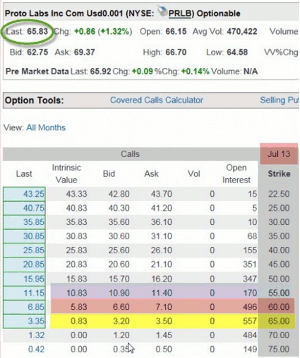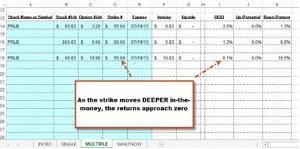As the strike price moves deeper in-the-money and the time value approaches zero, there will be some strikes that should not be used for covered call writing because they generate little or no time value, writes Alan Ellman of TheBlueCollarInvestor.com.
Maximizing covered call writing profits requires us to master strike price selection. Very few covered call writers outside the BCI community use in-the-money strikes, and as a result, do not achieve the results that we do. Recently, a few BCI members sent me emails commenting how in-the-money strikes do not generate profits that meet their goals. These members were looking for significant downside protection with a 2-4%, one-month return. In bearish or volatile markets, I am absolutely on the same page with these astute investors with the caveat that the term significant needs to be defined.
The deeper in-the-money the strike is, the more protection we have but the lower the time value component of the premium will be. There is a tradeoff…more protection for less profit and vice-versa. To demonstrate how this works, I have selected Proto Labs (PRLB), a stock on our Premium Watch List (6/28/13). The stock was trading @ $65.83 so let’s view three in-the-money strikes
- $65
- $60
- $55
Below is the options chain at the time of this writing (7-2-13):

PRLB-Options Chain
Click to Enlarge
Looking at the bid columns, we see the following covered call writing premiums:
- $65: $3.20 (yellow)
- $60: $6.60 (pink)
- $55: $10.90 (purple)
With 13 trading days remaining until expiration, let’s feed this information into the multiple tab of the Ellman Calculator:

PRLB & The Ellman Calculator
Click to Enlarge
The following conclusions can be made from these calculations:
- The returns on the options (ROO) is inversely related to the amount of downside protection.
- You will need to set your goals before determining which strike price is right for you.
- The deeper in-the-money a strike moves, the time value of the premium will approach zero.
Conclusion
In-the-money strikes offer downside protection of the time value component (our profit) of the option premium. This is very different from the breakeven, which is always the stock price minus the entire option premium generated from the option sale. The more downside protection we have, the lower the profit will be. Once we set our goals for our monthly returns, we can easily determine which strike price is most appropriate for our portfolios. However, as the strike moves deeper in-the-money and the time value approaches zero, there will be some strikes that should not be used for covered call writing because they generate little or no time value as is the case for the $55 call for PRLB.
By Alan Ellman of TheBlueCollarInvestor.com


















